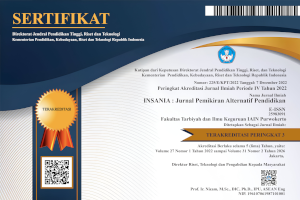Model-model evaluasi pendidikan
DOI:
https://doi.org/10.24090/insania.v13i2.292Keywords:
evaluation, learning, measurement model, illuminative model.Abstract
On learning literature, there many kind of learning model design, for example model developed by Winarno Surakhmad, Winkel, Hisyam Zaini et al., Briggs and Wager, Gerlach and Ely, and Kemp. Those models design have component and pattern that different each other, from model that have dominant quantitative measure like measurement model and model that using qualitative approach as illuminative model. By studying many models and broaden view not only to one model approach, and even combine (merger) between two or more models, or even developing our specific model. As one basic rule, good evaluation have to comply with several principle, namely validity, reliability, objectivity, continuity, and comÂprehensive so the resulted information can became source to make right and wise decision. On learning literature, there many kind of learning model design, for example model developed by Winarno Surakhmad, Winkel, Hisyam Zaini et al., Briggs and Wager, Gerlach and Ely, and Kemp. Those models design have component and pattern that different each other, from model that have dominant quantitative measure like measurement model and model that using qualitative approach as illuminative model. By studying many models and broaden view not only to one model approach, and even combine (merger) between two or more models, or even developing our specific model. As one basic rule, good evaluation have to comply with several principle, namely validity, reliability, objectivity, continuity, and comÂprehensive so the resulted information can became source to make right and wise decision. Keywords: evaluation, learning, measurement model, illuminative model.Downloads
Downloads
How to Cite
Issue
Section
License
Authors who publish with this journal agree to the following terms:
Authors retain copyright and grant the journal right of first publication with the work simultaneously licensed under a Creative CommonsAttribution-ShareAlike License that allows others to share the work with an acknowledgment of the work's authorship and initial publication in this journal.
Authors are able to enter into separate, additional contractual arrangements for the non-exclusive distribution of the journal's published version of the work (e.g., post it to an institutional repository or publish it in a book), with an acknowledgment of its initial publication in this journal.
Authors are permitted and encouraged to post their work online (e.g., in institutional repositories or on their website) prior to and during the submission process, as it can lead to productive exchanges, as well as earlier and greater citation of published work (See The Effect of Open Access).








